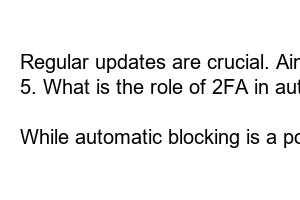보안 위험 자동 차단 설정
Title: Set Up Automatic Blocking of Security Risks: Stay One Step Ahead of Cyber Threats
Introduction:
In today’s digitally connected world, the risk of cyber threats has become more prevalent than ever before. As hackers become increasingly sophisticated in their methods, it is crucial for individuals and businesses alike to take proactive measures to protect their sensitive data and digital assets. One effective approach is to set up automatic blocking of security risks, which adds an extra layer of defense and helps ensure enhanced online security. This blog post will guide you through the process of implementing this powerful security feature, ensuring you stay one step ahead of potential threats.
1. Understanding the Importance of Automatic Blocking:
Automatic blocking is a proactive security measure that helps prevent unauthorized access and in turn, safeguards your online presence. By **automatically** blocking known security risks, you reduce the likelihood of falling victim to cyber attacks that could compromise your sensitive information.
2. Leveraging Firewall Technologies:
Firewalls play a vital role in protecting your network. With the right configuration, specific firewall technologies can assess incoming traffic and automatically block any malicious attempts to gain access. **Configuring an intelligent firewall** can minimize potential risks and fortify your digital defense.
3. Implementing Intrusion Detection and Prevention Systems (IDPS):
To supplement your firewall, setting up an IDPS can act as a second line of defense, guarding against potential security breaches and enhancing your overall security posture. **By deploying an IDPS**, your system becomes better equipped to detect and proactively block security threats in real-time.
4. Employing Threat Intelligence Solutions:
Today’s threat landscape evolves rapidly, making it essential to stay updated on emerging risks. By integrating threat intelligence solutions, you gain access to an extensive database of known malware, phishing attempts, and other security risks. **Leveraging threat intelligence** enables your system to automatically block suspicious activities, keeping your online environment secure.
5. Setting Up Automatic Software Updates:
Outdated software can provide easy access points for cybercriminals. Keeping your operating systems, applications, and plugins up to date is crucial for mitigating known vulnerabilities. Configure your systems to automatically update, so you never miss critical security patches, effectively blocking potential security risks.
6. Enabling Two-Factor Authentication (2FA):
Passwords alone offer limited protection, especially in the face of advanced hacking techniques. By enabling 2FA, you add an extra layer of security to your online accounts. This **additional authentication step** significantly reduces the risk of unauthorized access.
7. Regularly Monitoring and Auditing Systems:
While automated blocking measures can enhance your online security, continuous monitoring and regular audits are equally important. By actively monitoring your systems for potential vulnerabilities and performing routine audits, you can identify and rectify any security weaknesses before they escalate.
Summary:
In an increasingly interconnected world, automatic blocking of security risks is an indispensable strategy for fortifying your online defenses. By leveraging firewall technologies, implementing IDPS, employing threat intelligence solutions, enabling automatic software updates, enabling 2FA, and regularly monitoring and auditing your systems, you can significantly reduce the chances of falling victim to cyber threats. Stay proactive, stay secure, and maintain peace of mind knowing that your valuable digital assets are protected from potential harm.
Frequently Asked Questions (FAQs):
1. How does automatic blocking help protect against security risks?
Automatic blocking proactively identifies and blocks known security risks, reducing the likelihood of falling victim to cyber attacks.
2. Can I customize the automatic blocking settings?
Yes, you can configure automatic blocking settings to align with your specific security requirements and preferences.
3. Does setting up automatic blocking slow down network performance?
No, when correctly configured, automatic blocking does not significantly impact network performance.
4. How often should I update my systems?
Regular updates are crucial. Aim to update your systems and software as soon as security patches are released.
5. What is the role of 2FA in automatic blocking?
Enabling 2FA adds an additional layer of security, reducing the risk of unauthorized access even if passwords are compromised.
6. Do I still need to invest in other security measures?
While automatic blocking is a powerful security feature, it is essential to implement a multi-layered security strategy combining various measures to maximize protection against evolving threats.

